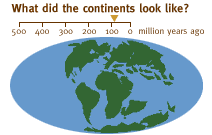Explore an Era:
Paleocene
65 - 54 million years ago
Mild Climate; little temperature fluctuation |
Significant mountain development in N. America |
Pines, cactii, palm trees develop |
Mammals expand; birds diversify |
None |
What was the Delaware Bay like? |
||||
At the beginning of the Paleocene, the world was practically without larger sized terrestrial animals. Only ten million years later, at the end of the Paleocene, mammals occupy a large part of the vacant ecological niches.
By the beginning of the Eocene, the landscape is teeming with small insectivorous and rodent-like mammals, and the first large mammals appear, along with primitive primates.
During the Paleocene, birds began to diversify and occupy new niches. Most bird types had appeared by the middle Cenozoic, including cranes, hawks, pelicans, herons, owls, ducks, pigeons, loons, and woodpeckers.
